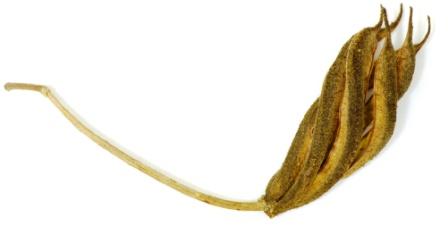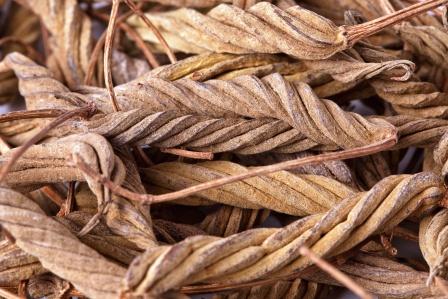Helicteres isora – Avartani – Uses, Dose, Research, Side Effects
Helicteres isora – East Indian Screw tree is an Ayurvedic herb used in treating diarrhoea, dysentery, abdominal colic pain, intestinal parasites etc. Its root,stem bark, and fruits are used for medicinal purposes.

There is a famous quote in Ayurveda – Yatra Akrutihi Tatra Gunaaha Vasanti.
Meaning, if the part of a plant resembles some organ, it is useful in treating disorders of that particular organ. Avartani means rotating. The fruits of Helicteres isora are twisted. The fruits give an imagination about intestines. Hence they are useful in treating intestinal parasites. The fruits are twisted, hence they are useful in twitching pain in the abdomen.
Botanical name- Helicteres isora Linn
Family- Sterculiaceae (Pishacha karpasa kula)
Table of Contents
Vernacular names
Names in different languages:
Hindi name- Marod phali, Marodphali, Marophali
English name-Indian screw tree
Tamil name- Valipiri
Telugu name- Nunidala Guba tasa, Guvardara
Gujarati name – Maradasing
Urdu name – Murmuriya
Malayalam name- Isvaramuri
Bengali name – Antmora
Kannada name – Peda muri
Sanskrit Synonyms
Avartani, Avarta Phala – Fruit is twisted
Vamavartha – Fruit is winded towards left
Mrigashringi – Fruit resembles the stag’s horn

Chemical composition
Helicteres isora chemical composition
Diosgenin, Cucurbitacin B, isocucubitacin B, Isorin etc
(Reference: Illustrated Dravyaguna Vijnana, Vol. II, by Dr JLN Shastry)
Medicinal properties
Helicteres isora medicinal properties:
Guna (qualities) – Laghu, Ruksa
Rasa (taste) – Kashaya – astringent
Vipaka- Katu – Undergoes pungent taste conversion after digestion
Veerya – Sheeta – Coolant
Effect on Tridosha – Balances Kapha and Pitta
Pharmacological action – Demulcent, Astringent, Vermifuge, Expectorant, Antispasmodic, Hypolipidemic
Part used, dosage
Parts used- Root, Stem bark, Fruit
Dosage-
Fruit powder 3-6 g
Kashaya – decoction 50-100 ml in divided doses per day.
Indications
Indicated in –
Atisara – diarrhea, dysentery
Shoola – abdominal colic pain
Krumi – worm infestation and bleeding disorders.
Use in Children
Marod Phali is used in children above two years of age for diarrhea and abdominal colic pain. It is used in very small quantities of 250 mg or one pinch along with milk. But you have to consult an Ayurveda doctor before using it. Self medication can be very dangerous.
Interaction with medicines, supplements
Can this be used while taking Homeopathic medicine?
Yes. This product does not react with homeopathic medicine.
Can this medicine be continued while taking supplements like multivitamin tablets, Omega 3 fatty acids etc?
Yes. Generally, this product goes well with most dietary supplements. However, if you are taking more than one product per day, please consult your doctor for an opinion.
With western
medicines
Seek your
doctor’s advice if you are taking this product along with other western
(allopathic / modern) medicines. Some Ayurvedic herbs can interact with modern
medicine.
If both Ayurvedic and allopathic medicines are advised together, then it is
best to take Allopathic medicine first, wait for 30 minutes and then take the
Ayurvedic medicine.
Research
Antidiabetic and hypolipidemic activity of Helicteres isora in animal models.
Antioxidant and antidiabetic activity
Proprietary Ayurvedic medicines with Marodphali as ingredient:
Dysentrol tablet – manufactured by Shree Dhanwantari Herbal Pharmaceuticals. It is an anti-diarrhoeal drug.
Morphology
Shrub or small tree
Bark – Reddish brown in color
Leaf -Simple, closely dotted with stellate hairs
Flowers – Seen in axillary clusters
Fruit – Follicle, linear, twisted into the form of a screw
Systemic Action
External – Styptic, Wound healing properties. Seed powder can be used for sprinkling in bleeding conditions, wounds etc.
Digestive System – It has absorbent and Anthelmintic action. Indicated in abdominal colic pain, Diarrhea, Helminthiasis etc.
Circulatory System – indicated in bleeding disorders, bloody diarrhea etc.
Respiratory system –Pacifies kapha dosha. useful in cough
Excretory system – Reduces urine production. Root bark is indicated in Diabetes.











One comment
Khalid
Hello,
Is this herb available for use in Mumbai and In form form?